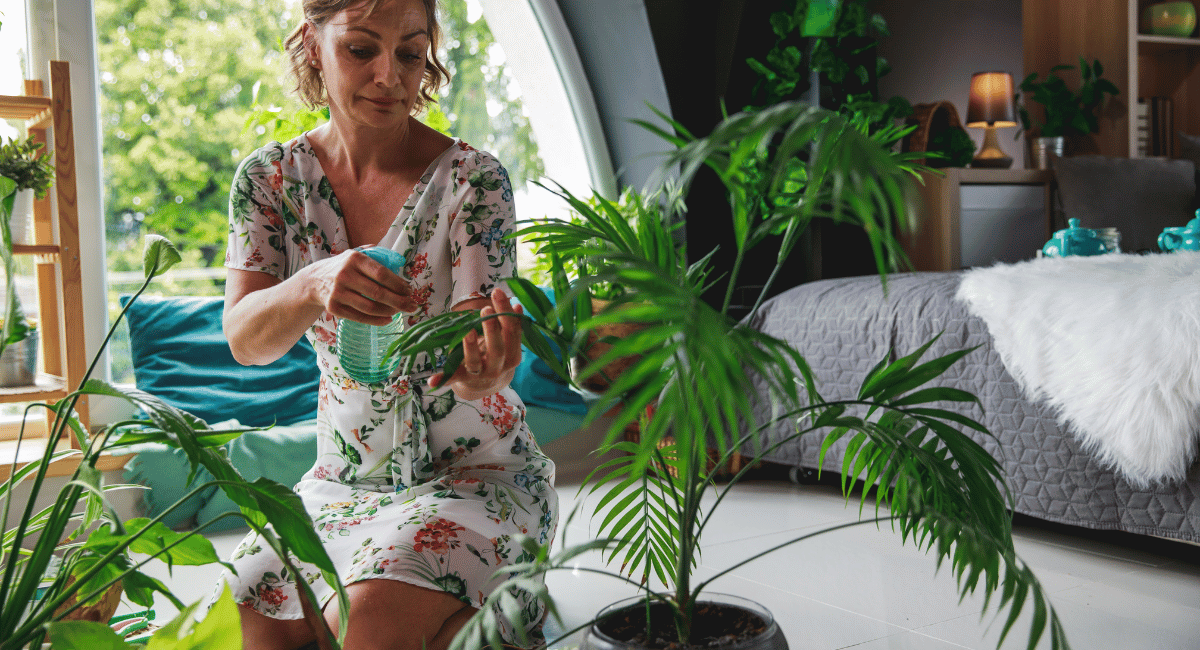Indoor plants add beauty and life to your living spaces and can improve air quality by filtering out common volatile organic compounds (VOCs) and other pollutants. According to research, including the famous NASA Clean Air Study, certain plants are particularly effective at purifying indoor air. Here are 10 of the best air-purifying indoor plants, noted for their ability to improve indoor air quality:
Spider Plant (Chlorophytum comosum)
- Air-Purifying Qualities: Exceptionally good at absorbing toxins such as formaldehyde and xylene from the air. It’s one of the most effective plants at combating indoor air pollution, especially in spaces with furniture that may off-gas formaldehyde.
- Care Tips: Spider plants prefer cool to average home temperatures and indirect sunlight. They’re very forgiving and can thrive even in less-than-ideal light conditions. Keep their soil slightly moist in the warmer months and reduce watering in the winter.
Snake Plant (Sansevieria trifasciata)
- Air-Purifying Qualities: It’s especially effective at filtering out formaldehyde, common in cleaning, toilet paper, tissues, and personal care products. This plant also absorbs carbon dioxide and releases oxygen at night (unlike most plants), making it an excellent choice for bedroom decor.
- Care Tips: Snake plants prefer dry conditions and some direct sunlight. They require minimal water, making them perfect for those often away from home or needing to remember to water.
Peace Lily (Spathiphyllum)
- Air-Purifying Qualities: The Peace Lily can remove many toxins from the air, including ammonia, benzene, formaldehyde, and trichloroethylene. Its ability to filter harmful toxins is matched by its visually appealing white blooms.
- Care Tips: Prefers shady areas and needs to be kept in moist soil without overwatering. Peace lilies are also sensitive to chemicals commonly found in tap water; using filtered water can prevent brown leaf tips.
Rubber Plant (Ficus elastica)
- Air-Purifying Qualities: Rubber plants are excellent for cleaning the air of formaldehyde. Not only do they filter out air pollutants, but they’re also known for their large leaves, which can absorb more contaminants.
- Care Tips: Thrives in indirect light and requires less water than other plants. Allow the top inch of soil to dry out between waterings. Wiping the leaves off with a damp cloth can help the plant absorb more light.
Boston Fern (Nephrolepis exaltata)
- Air-Purifying Qualities: This plant is known for removing formaldehyde and xylene from the air. Its lush, green fronds add humidity to the air, making it beneficial for those living in dry climates.
- Care Tips: Boston ferns prefer a fantastic place with high humidity and indirect light. They require consistent moisture, so keeping the soil damp and misting the leaves regularly is essential.
Bamboo Palm (Chamaedorea seifrizii)
- Air-Purifying Qualities: Excellent at filtering benzene and trichloroethylene, the Bamboo Palm is also a natural humidifier that releases moisture into the air.
- Care Tips: Prefers bright, indirect sunlight and does well in areas with some shade. Water when the top soil feels dry, and ensure good drainage to prevent root rot.
Aloe Vera (Aloe barbadensis miller)
- Air-Purifying Qualities: Known for its ability to help clear formaldehyde and benzene, which can be a byproduct of chemical-based cleaners, paints, and more.
- Care Tips: Aloe Vera thrives in bright, indirect sunlight or artificial lighting. Water deeply but infrequently, allowing the soil to dry out completely between waterings.
English Ivy (Hedera helix)
- Air-Purifying Qualities: This plant is particularly effective at reducing airborne fecal particles, making it excellent for bathroom decor. It also filters out formaldehyde.
- Care Tips: Prefers moist soil and cooler room temperatures. It requires four or more hours of direct sunlight each day, so placing it near a window that gets light is ideal.
Golden Pothos (Epipremnum aureum)
- Air-Purifying Qualities: A hardy plant that removes formaldehyde and carbon monoxide. Its trailing vines can absorb and strip toxins from materials like carpets and area rugs.
- Care Tips: Deficient maintenance, thriving in various lighting conditions, and requiring minimal watering. Allow the soil to dry out completely between waterings.
Philodendron
- Air-Purifying Qualities: Particularly effective at absorbing formaldehyde, philodendrons are a popular choice for their air-purifying properties and ease of care.
- Care Tips: Prefers moderate to bright indirect sunlight and needs to be watered when the top inch of soil is dry. Be cautious, as they can be toxic to pets if ingested.
Incorporating these air-purifying plants into your home can contribute to a healthier indoor environment, reducing pollutants and improving air quality. Remember, while indoor plants can help filter the air, they should complement other air-purifying strategies like good ventilation and regular cleaning rather than replace them.










